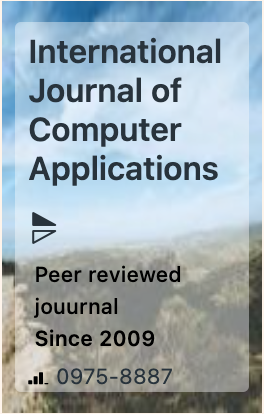The week's pick
Random Articles
Reseach Article
AI-Powered Database Security: Sophisticated Techniques to Identify and Neutralize Threats
| International Journal of Computer Applications |
| Foundation of Computer Science (FCS), NY, USA |
| Volume 186 - Number 77 |
| Year of Publication: 2025 |
| Authors: Sanjay Bauskar |
 10.5120/ijca2025924576
10.5120/ijca2025924576
|
Sanjay Bauskar . AI-Powered Database Security: Sophisticated Techniques to Identify and Neutralize Threats. International Journal of Computer Applications. 186, 77 ( Apr 2025), 11-16. DOI=10.5120/ijca2025924576
Abstract
Due to the rapid data generation in various fields, database security has become essential because firms use technology to store vital data. Cyber threats have changed in sophistication, and now strategies such as firewalls, encryption, and access controls are insufficient to respond to these threats. These are threats such as Advanced Persistent Threats APTs, Zero Day Vulnerabilities and Insider Attacks. These are threats that can stealth past traditional Security solutions. The consequences can be significant, and appropriate evasion attracts monetary loss, reputation smear and legal consequences when the breaches are attained. Thus, there is a need to transform security from a mostly conventional and linear approach to a more intelligent and dynamic response. This paper focuses on the possibilities of using Artificial Intelligence (AI) and machine learning to improve database security. Artificial intelligence systems can process heaps of data simultaneously and algebraically, and as a result, they can easily detect such slight irregularities, suggesting that something calamitous is going on. In contrast, AI systems learn how attacks occur and progress over time; hence, they work against emergent threats. Machine learning algorithms, specifically deep learning, increase prediction capability by identifying patterns and behavior is that suggest an attack. Also, AI automates threat responses, which cuts reaction time when confronting threats and malfunctions and their consequent harms. This work discusses a wide range of AI-based frameworks and methodologies for analyzing attacks and real-world solutions. It shows how the state of the art is superior to prior art solutions and sets optimal database security.
References
- Kavitha, D., & Thejas, S. (2024). AI-Enabled Threat Detection: Leveraging Artificial Intelligence for Advanced Security and Cyber Threat Mitigation. IEEE Access.
- Khan, A., & Sharma, I. (2024, January). AI-Powered Detection and Mitigation of Backdoor Attacks on Databases Server. In 2024 2nd International Conference on Intelligent Data Communication Technologies and Internet of Things (IDCIoT) (pp. 374-379). IEEE.
- Lesov, P. (2010). Database Security: A Historical Perspective. arXiv preprint arXiv:1004.4022.
- Bertino, E., & Sandhu, R. (2005). Database security concepts, approaches, and challenges. IEEE Transactions on Dependable and Secure Computing, 2(1), 2-19.
- AI in Cybersecurity: Enhancing Threat Detection and Prevention, Cyber Security & Ethical Hacking, online. https://bostoninstituteofanalytics.org/blog/ai-in-cybersecurity-enhancing-threat-detection-and-prevention/
- Paul, P., & Aithal, P. S. (2019). Database security: An overview and analysis of the current trend. International Journal of Management, Technology, and Social Sciences (IJMTS), 4(2), 53-58.
- Mousa, A., Karabatak, M., & Mustafa, T. (2020, June). Database security threats and challenges. In 2020 8th International Symposium on Digital Forensics and Security (ISDFS) (pp. 1-5). IEEE.
- George, B., & Valeva, A. (2006). A database security course on a shoestring. ACM SIGCSE Bulletin, 38(1), 7-11.
- Role of Artificial Intelligence in Cybersecurity, Jaroeducation, 2024. online. https://www.jaroeducation.com/blog/artificial-intelligence-in-cybersecurity/
- Kuzlu, M., Fair, C., & Guler, O. (2021). Role of artificial intelligence in the Internet of Things (IoT) cybersecurity. Discover Internet of Things, 1(1), 7.
- Geluvaraj, B., Satwik, P. M., & Ashok Kumar, T. A. (2019). The future of cybersecurity: Major role of artificial intelligence, machine learning, and deep learning in cyberspace. In International Conference on Computer Networks and Communication Technologies: ICCNCT 2018 (pp. 739-747). Springer Singapore.
- Chris Scheels, AI-Powered Threat Detection: The Future of Cyber Defense, online. https://www.thefastmode.com/expert-opinion/38944-ai-powered-threat-detection-the-future-of-cyber-defense
- Barreno, M., Nelson, B., Joseph, A. D., & Tygar, J. D. (2010). The security of machine learning. Machine learning, 81, 121-148.
- Xue, M., Yuan, C., Wu, H., Zhang, Y., & Liu, W. (2020). Machine learning security: Threats, countermeasures, and evaluations. IEEE Access, 8, 74720-74742.
- Balantrapu, S. S. (2024). A Comprehensive Review of AI Applications in Cybersecurity. International Machine Learning Journal and Computer Engineering, 7(7).
- Data security in AI systems: Types of threats, principles and techniques to mitigate them and best practices, leeway hertz, online. https://www.leewayhertz.com/data-security-in-ai-systems/
- Hofstetter, M., Riedl, R., Gees, T., Koumpis, A., & Schaberreiter, T. (2020, September). Applications of AI in cybersecurity. In 2020 Second International Conference on Transdisciplinary AI (TransAI) (pp. 138-141). IEEE.
- Rajaram, S. K., Galla, E. P., Patra, G. K., Madhavaram, C. R., & Rao, J. (2022). AI-Driven Threat Detection: Leveraging Big Data For Advanced Cybersecurity Compliance. Educational Administration: Theory and Practice, 28(4), 285-296.
- Hlaing, Z. C. S. S., & Khaing, M. (2020, February). A detection and prevention technique on SQL injection attacks. In 2020 IEEE Conference on Computer Applications (ICCA) (pp. 1-6). IEEE.
- Syed, A. (2024). AI-Powered Threat Detection and Mitigation. In Supply Chain Software Security: AI, IoT, and Application Security (pp. 249-287). Berkeley, CA: Apress.
Index Terms
Keywords

